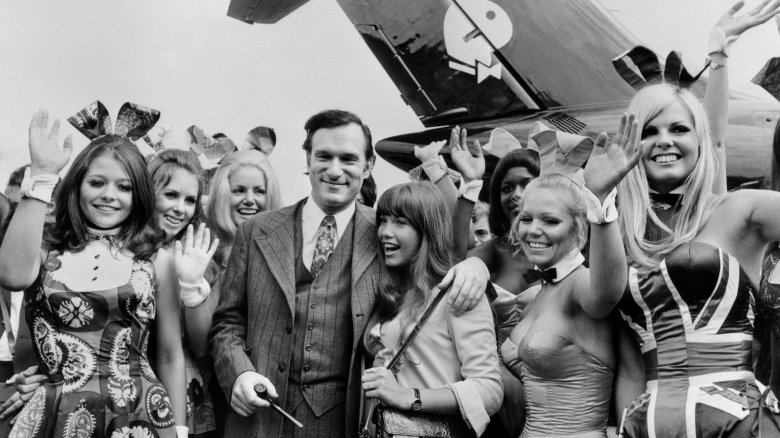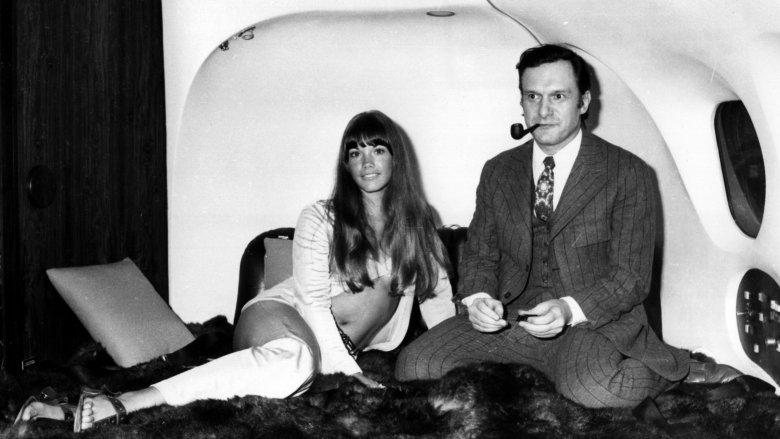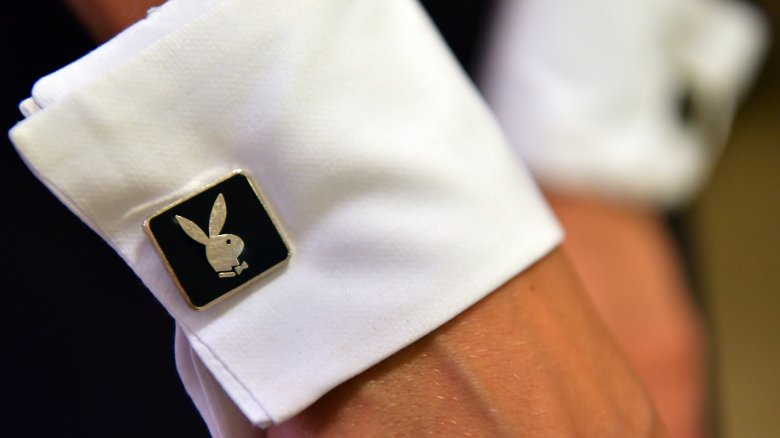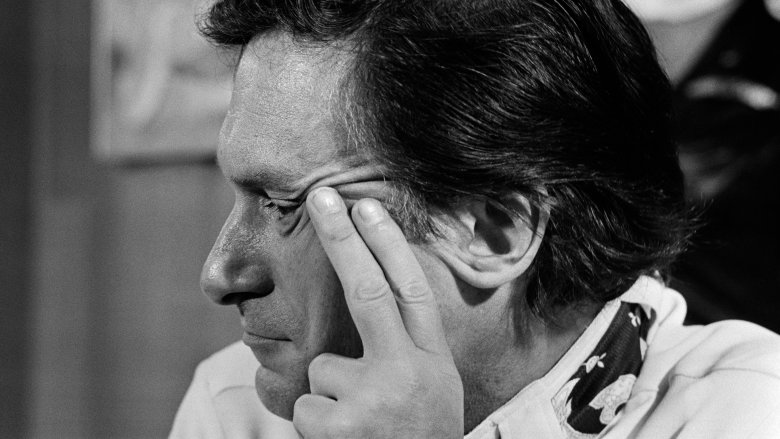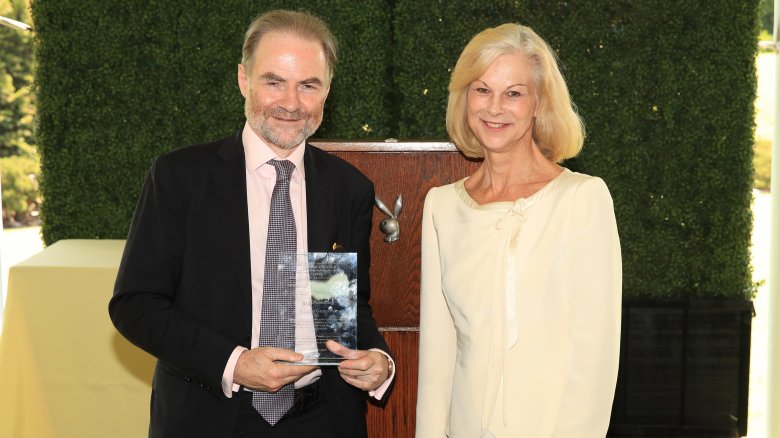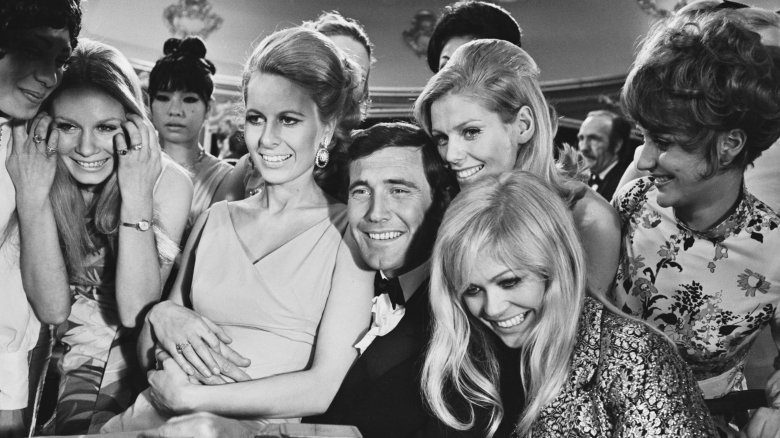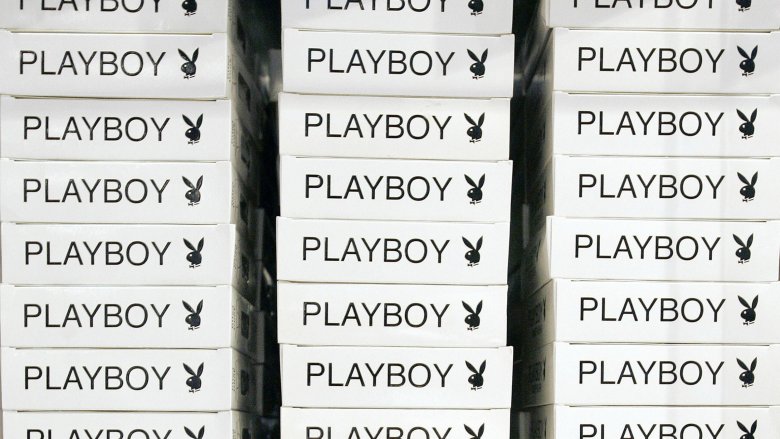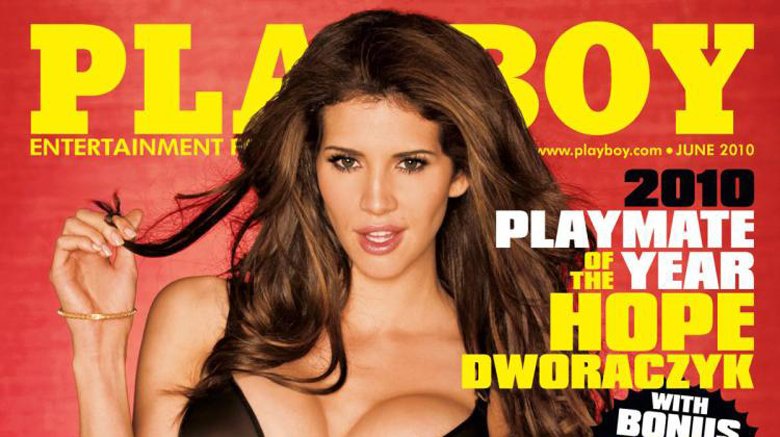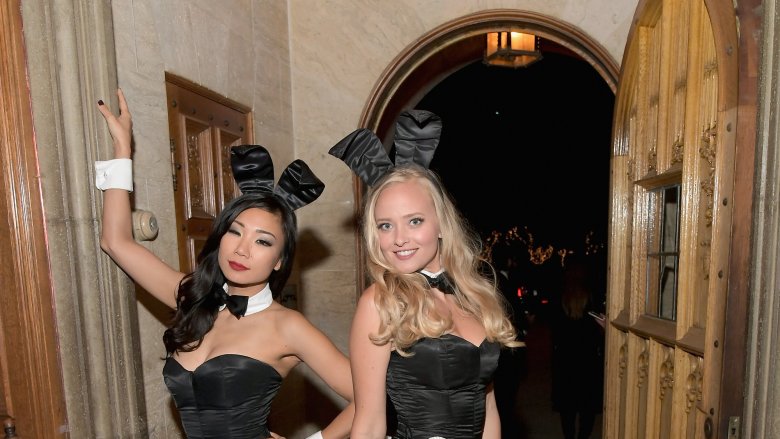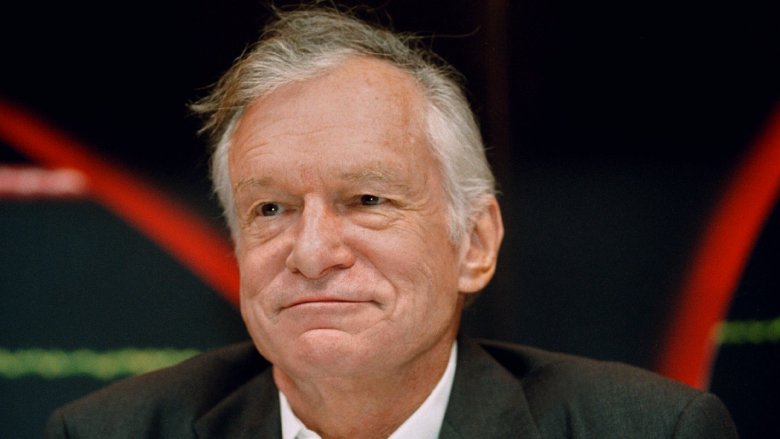The Untold Truth Of Playboy
Playboy is one of the most iconic American publications of all time, boasting a peak circulation of 5.6 million copies in 1976. But the creation of founder and longtime editor-in-chief, Hugh Hefner, was much more than just titillating nudie pics. Playboy has been a trailblazer of American counterculture. Here are some of the lesser-known facts surrounding Hefner's pet project — good, bad, and ugly. This is the untold truth of Playboy.
Hefner sold his furniture to fund the magazine
In December 1953, Hefner reportedly "mortgaged" the furniture from "what would be his first wedding," according to The Chicago Tribune, for a $600 loan. He took that and some other money borrowed from those close to him and used it to publish the first edition of Playboy, according to People.
In an interview with Time (via Australia's ABC News), Hefner spoke of the first issue in relation to the state of America's sexual politics at the time. "When I first published Playboy magazine and certainly when I grew up and when I was in college, having a baby out of wedlock was a scandal. A scandal that drove some people to suicide. Abortion was illegal, oral sex was a major felony. Even oral sex inside of a marriage was illegal, and very few people know that. Playboy played a major part in changing all those laws," Hefner said. Who would've guessed one of Hefner's proudest achievements would have been the de-stigmatization of married oral sex? Oh right, everyone.
Hefner wanted to call the magazine 'Stag Party'
Considering part of Playboy's mission statement declared the magazine's intended readership was men who "enjoy mixing up cocktails and an hors d'oeuvre or two, putting a little mood music on the phonograph and inviting in a female acquaintance for a quiet discussion on Picasso, Nietzsche, jazz, sex," it's kind of remarkable that Hefner's original title was Stag Party. That hardly evokes an air of cosmopolitan elegance.
Luckily for Hefner, his longtime art director, Art Paul was with him from the very beginning. "Hef was very insistent that the magazine be called Stag Party — I told him it was madness," Paul told IIT Magazine. A hunting magazine named Stag didn't like the idea, either. After brainstorming new "titles and animals that would represent a frisky slice of life," another founding associate, Eldon Sellers, pitched the title, Playboy. The iconic bunny logo that would eventually come to represent a merchandising juggernaut also came at this time.
The iconic logo wasn't originally intended to represent the brand
Art Paul also told IIT Magazine that the bunny logo took him "about one hour to sketch" and that they were only going to use it "as a characteristic endpoint to articles, but those plans changed." That understatement is echoed by every T-shirt, trinket, and sunburn tattoo emblazoned with the now ubiquitous rabbit head. As for why they chose that particular animal? "The word 'playboy' itself is not a serious one. The rabbit is not serious; it was basically a signal that we could make fun of ourselves," Paul said.
Hefner described his own admittedly quirkier reasons for the mascot choice in a 1976 interview excerpted by the book, Sex in Language. "The rabbit, the bunny, in America has a sexual meaning; and I chose it because it's a fresh animal, shy, vivacious, jumping — sexy. First it smells you then it escapes, then it comes back, and you feel like caressing it, playing with it. A girl resembles a bunny. Joyful, joking. ... The Playboy girl has no lace, no underwear, she is naked, well-washed with soap and water, and she is happy," Hefner said. Yep, that's extremely weird. All of it. Moving on.
The magazine once featured a 16-year-old centerfold
According to The New Yorker, Hefner found himself in hot water early in his publishing career in 1958 when the magazine "published a centerfold of a 16-year-old girl." Hefner faced charges of contributing to the delinquency of a minor, but the case was dismissed after he produced "written permission from her mother," which at the time was apparently a good enough legal defense for taking semi-nude photos of a high-schooler.
The inherent grossness of the teenager's mother notwithstanding, Hefner did allegedly adjust the magazine's age policy to "never again publish a photograph of an unclothed woman under 18." After that, he often picked girls who only looked like they were minors, The New Yorker reported. Whew.
The decision to remove nudity from the magazine actually worked
In 2015, Playboy decided to remove nudity from the magazine, citing widely available and free internet porn as a key factor. "That battle has been fought and won," Playboy chief executive Scott Flanders told The New York Times, adding, "You're now one click away from every sex act imaginable for free. And so it's just passe at this juncture." The new, nipple-free editions of the mag lasted about a year before they reversed the decision.
Having also undergone a shift in management — Hefner's son Cooper stepped into the role of chief creative officer — the brand shifted back to its roots with a February 2017 tweet from Cooper that stated, "I'll be the first to admit that the way in which the magazine portrayed nudity was dated, but removing it entirely was a mistake. Nudity was never the problem because nudity isn't a problem. Today we're taking our identity back and reclaiming who we are."
That all sounds great, except the not-nude move was actually working. According to sales figures reported by the Alliance for Audited Media (via New York Post), single-copy sales increased "to 47,203 a month." A Playboy spokesman even reported an uptick of 100,000 new subscribers as of September 2016. So why change back?
Speaking with LA Weekly in July 2016, Cooper said, "People who are young don't view nudity as a problem. I mean, Vogue today has nudity. The problem was how Playboy presented the nudity." Got it, so Playboy is now chasing the elusive "youth audience" with their naked pictorials. Could that mean a tastefully unclad Pokémon hunt could be in the works?
The magazine has been a champion for free speech
Though naked Playmates are usually the first thing anyone thinks about in association with Playboy, the magazine and Hefner have been recognized as defenders of free speech. In 2010, Hefner was awarded the First Amendment Award by Pen Center USA, which describes the honor as being "given to a candidate who has done work in the domestic United States to protect the First Amendment." The distinction puts Hefner among other prestigious recipients like outspoken political critic Bill Maher and investigative journalists Glenn Greenwald and Laura Poitras, who broke the Edward Snowden/NSA story.
Through the Hugh Hefner Foundation, Hefner's daughter, Christie, who served as a longtime head of Playboy Enterprises, set up the brand's own way to recognize free speech pioneers by establishing their own First Amendment awards. Since 1979, the foundation has awarded multiple recipients per year "whose actions support and often fight to preserve the values of the First Amendment."
Major literary works were serialized in the magazine
The old joke about Playboy, of course, is "I buy it for the articles," and while the centerfolds have clearly supplied the drawing power for "readers," the magazine developed into something of a literary powerhouse throughout the '60s and '70s. There are almost too many heavy-hitting authors to mention who have contributed to Playboy, but according to the BBC, the list includes John Steinbeck, Jack Kerouac, Arthur C. Clarke, Margaret Atwood, Haruki Murakami, and many more.
In fact, Ray Bradbury's classic, Fahrenheit 451 — remember that from your 7th grade summer reading list? — was reportedly never exposed to a mass audience until Hefner "paid $400 for the rights to serialize it the following year." He did the same thing with a little novel called On Her Majesty's Secret Service, you know, just one of Ian Fleming's James Bond novels that was later adapted into a blockbuster film.
For these — and many more — contributions to the literary world, Hefner was also given the Award of Honor from Pen Center USA. Jamie Wolf, vice president of the organization, told the BBC, "[Hefner] published Saul Bellow, he published Gabriel Garcia Marquez, he published John Updike, he published an extraordinary range of writers, serious literary writers who you were not otherwise getting when you went into the grocery store. And he was paying them substantial wages. And some of them were blacklisted writers who other people wouldn't publish." So, yes, it would seem someone was reading the articles.
China basically saved the company
According to The New York Times, a lot of the decision to remove nudity from the magazine reportedly came from Playboy's dependence on the Chinese market's apparently voracious appetite for their merchandise, which at the time of their reporting amounted to "40 percent of that business." Combined with the fact that at the time, "the United States edition [of the magazine] was losing about $3 million a year" and could only be "considered profitable if money from licensed editions around the world is taken into account," the success of the brand's merchandise was mission critical. It's especially interesting, because the actual magazine is banned from the notoriously conservative mainland China — although available in Hong Kong — and yet, they can't seem to get enough of Playboy-branded paraphernalia.
Quartz backed the New York Times' findings with even more eye-opening figures that point to just how reliant on the Chinese market the entire Playboy enterprise truly is. From 2009 to 2013, the company's annual licensing revenues shot up a whopping $28 million and represented approximately half of the company's overall revenues at the time. That means that if Chinese consumers decide to be nonplussed with the reintroduction of naughty bits in the mag, they could collapse the whole company with their purchasing power. Um, has anyone told Cooper?
There's a hidden bunny on every cover
Since the second issue of the magazine, when Art Paul's now-infamous bunny logo was debuted, Playboy has ensured that the iconic logo has appeared in some shape or form. It's said that hiding the logo started as a joke, but it's now something the publication has stuck with for decades. Don't believe us? Wait until you leave work, or at least fire up incognito mode, and do a basic Google search for "Playboy cover." While you're at it, see if you can spot the one we picked up there. (Hint: Eyes up top, you scamp.)
The magazine was an influencer in the architecture and design space
Considering Hefner's aforementioned "Picasso, Nietzsche, jazz" hipster-before-hipsters-were-a-thing aesthetic, it's no surprise that over the years he spent almost less time focusing on the centerfolds, and more time focusing on the architectural implications of the chairs they bent over. At least, that's according to historian Beatriz Colomina, who headed a Princeton study examining the Playboy founder's obsession with design.
Speaking with Architecture Magazine, Colomina said that from the very beginning, and because of the magazine's Chicago roots, it represented "avant-garde architects" like Frank Lloyd Wright, Mies Van Der Rohe, and "the whole generation of the 1950s: Nelson, Eames, Saarinen, all of them." Colomina even went as far as saying, "Playboy did more for modern architecture and design than any architectural journal or even the Museum of Modern Art."
But don't misunderstand, Hefner's motivations always led back to his primary focus. "They really felt that this was an important tool — actually crucial — for seduction," Colomina said, adding, "The modern apartment is a necessity for the bachelor, who has to surround himself with all these gadgets and all this modern furniture, and eventually even the architecture, the Playboy Pad. These are the settings in which seduction [happens]." Romance through feng shui. Genius.
Hefner used the magazine to advocate for civil rights
Through the years, Playboy was a flashpoint for many cultural happenings, including free speech advocacy, literary enlightenment, and cutting-edge design appreciation. Civil rights can also easily be added to that list.
In an interview with CBS Los Angeles, Hefner said, "I felt from a very early age that there were things in society that were wrong, and that I might play some small part in changing them." He then went on to list exactly how he tried to do that, including the desegregation efforts at his Playboy Clubs that even involved him buying back franchises from owners who refused minority members and performers at the front door. He also said that he sought out relationships with Rev. Jesse Jackson and Martin Luther King Jr. — the magazine just so happened to print the "last published piece written" by King before his death — and was instrumental in "the funding of PUSH and the Rainbow Coalition." But wait, there's more.
Hefner also gave a platform to Miles Davis in the first-ever Playboy interview during which the jazz legend "didn't talk so much about music, he talked about wishes and equality." According to People, Hefner also strongly advocated for gay rights, women's reproductive rights, and religious freedom. In short, this was a man who was about living free, and he used every platform available to him to push that agenda.
It probably doesn't outweigh the fact that he exploited an underage girl and published plenty of jailbait, but nothing is black and white.
